Rucervus schomburgki Blyth, 1863:155
Schomburgk's deer
Taxonomy & Nomenclature
Synonym/s: Cervus schomburgki Blyth, 1863:155; Cervus duvaucelii schomburgki Blyth, 1863:155; Thaocervus schomburgki Blyth, 1863: 155.
Conservation Status
Extinct (WCMC, 1992:214)
Last record (wild): 1932 (Goodwin & Goodwin 1973; WCMC, 1992:214); 1938 (Fisher & Blomberg, 2012)
Last record (captivity): 1938 (Duckworth et al., 2015a,b)
IUCN RedList status: Extinct
The last wild individuals died in 1932, while the last captive individual survived until 1938 (Duckworth et al., 2008).
Distribution
Thailand
Although Schomburgk's deer has been stated by various authors as inhabiting the countries surrounding Thailand (e.g. China: Bentham, 1908; Sclater, 1891), none of these occurrences has been corroborated by independent witnesses and the species is best considered as endemic to Thailand (Duckworth, 2015b).
Biology & Ecology
Hypodigm
Apparently hundreds of antlers and skulls of this species exist, taken as trophies by hunters. Ward (1892:19) lists six sets of antlers in various collections.
Media
Historical photos
More research needs to conducted into establishing the dates and photographers of the following seven known photos of living Schomburgk's deer.

Above: photo from the 1899 Berlin Zoo (Zoologischer Garten Berlin) Guidebook. Source: https://www.zoochat.com/community/media/schomburgks-deer.213045/
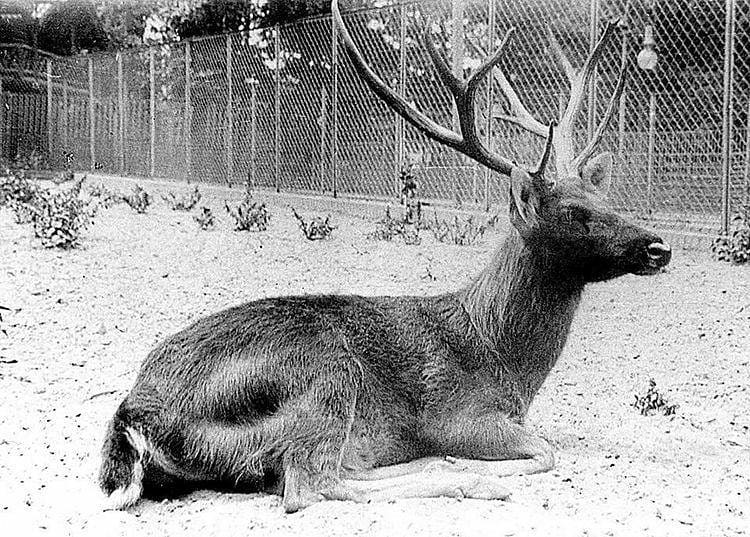
Above: Berlin Zoo (Zoologischer Garten Berlin), c.1904
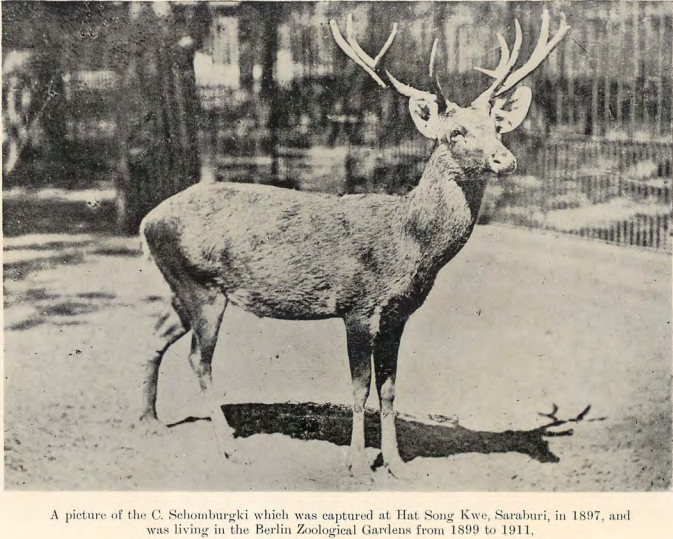
Above: male in the Berlin Zoo (Zoologischer Garten Berlin) possibly taken in 1905 (Giles, 1937:3, pl. 2), and formerly in the possession of a Mr. Chance, and then Mr. A. H. Duke. It is extremely similar to the second photo below, allegedly taken by Lothar Schlawe in 1911, however there are three noticeable differences, a) the placement of the antlers (compare the even height of the outer right two tips here with the uneven height of them in the Schlawe photo below), b) the corresponding absence of a shadow running down the animal's head and neck, and c) the lighter background which is less shadowy. It seems likely given the similarities of the two photos, despite their minor differences, that they were taken seconds apart and thus both either date from 1905 or 1911 and thus were taken by a single individual (likely but not certain to be either Mr. Chance or Lothar Schlawe).
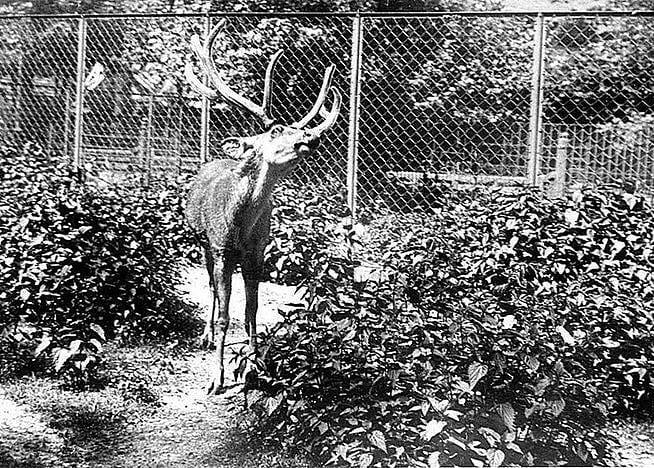
Above: Berlin Zoo (Zoologischer Garten Berlin), c.1908.
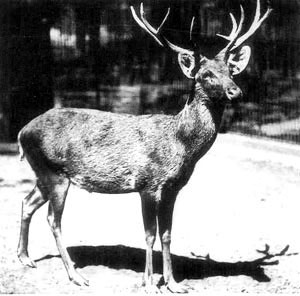
Above: Berlin Zoo (Zoologischer Garten Berlin). Photo possibly by Lothar Schlawe in 1911. Source: Wikimedia Commons.
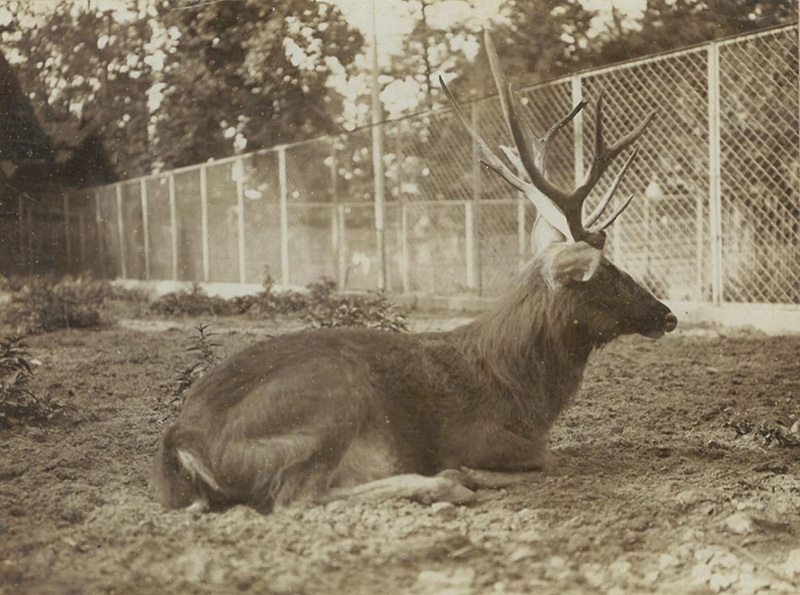
Above: male in the Berlin Zoo (Zoologischer Garten Berlin). Photo held by the Aquazoo Löbbecke Museum, Düsseldorf (Germany). Brought to my attention (discovered?) by Pedro Henrique Amancio Padilha and Andrew Vamvatsikos. Photographer unknown.
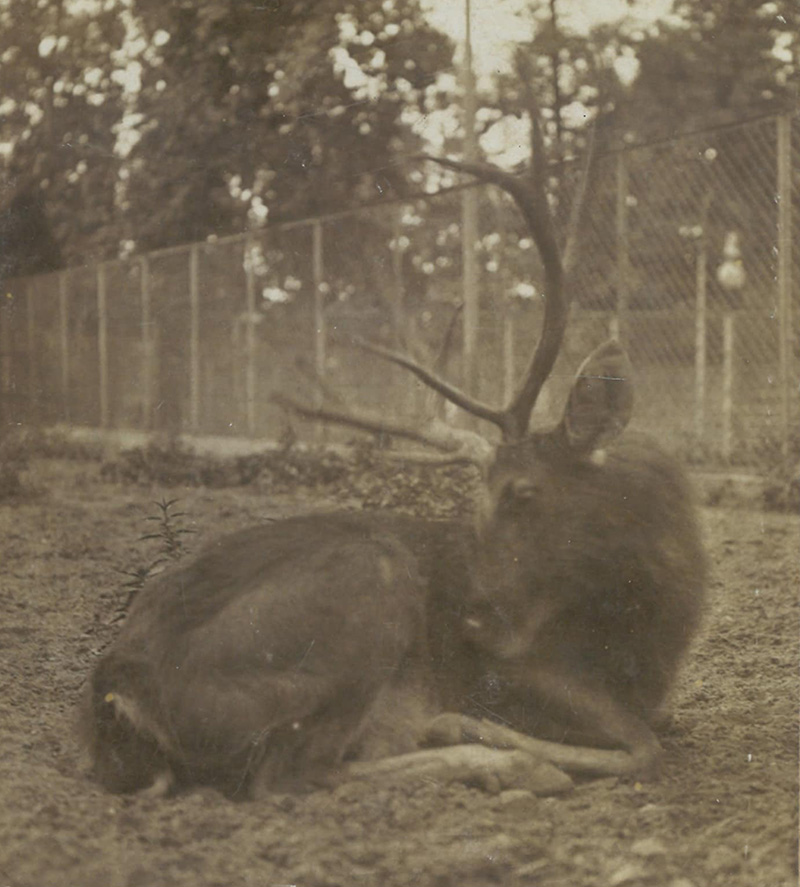
Above: male in the Berlin Zoo (Zoologischer Garten Berlin). Photo held by the Aquazoo Löbbecke Museum, Düsseldorf (Germany). Brought to my attention (discovered?) by Pedro Henrique Amancio Padilha and Andrew Vamvatsikos. Photographer unknown.
Discredited photo
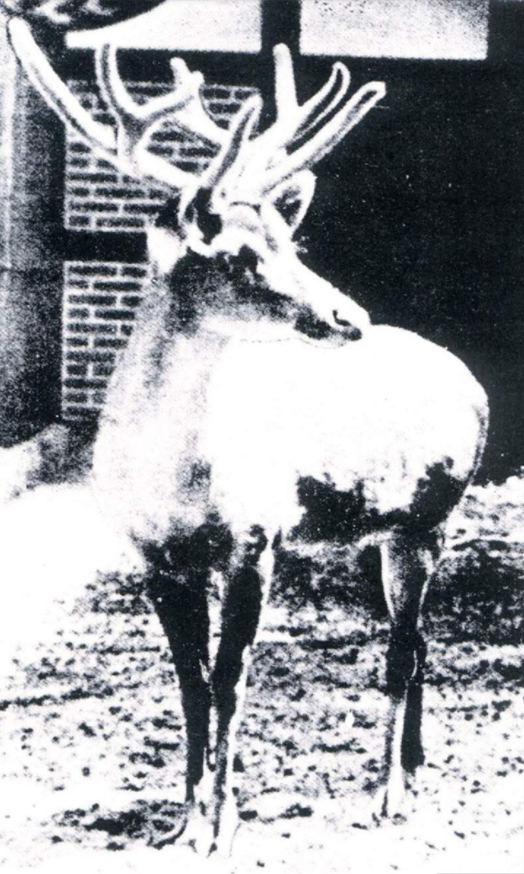
Above: photographer and date unknown. Published in สาระนาค (2007). Source: https://www.facebook.com/DNP.Wildlife/photos/a.1817818245209474/2852288841762404/
The above photo can be found in several places on the internet, always identified as a Schomburgk's deer. However, Laura, owner of the blog Endling Musings on tumblr (https://endlingmusings.tumblr.com/), has investigated the photo and found it to represent a barasingha or swamp deer (Rucervus duvaucelii) stag at Woburn Abbey in Bedforshire, England. She points out to me that the antlers and the visible portion of the building in the photo are identical to those in a second photo of this individual, clearly identified as a barasingha or swamp deer (Lydekker, 1900:230).
References
Original scientific description:
Blyth, E. (1863). Mr. E. Blyth on some horns of ruminants. Proceedings of the Zoological Society of London 1863, pg. 155-158.
Other references:
สาระนาค, ธนพล. (2007). ความฝันที่เป็นจริง ของคุณหมอบุญส่ง. Publisher?
Antonius, O. (1937). Zwei Abbildungen vom Schomburgk-Hirsch (Rucervus schomburgki Blyth) aus Zoologischen Gärten. D. Zool. Garten (NF) 8, 209-211.
Bazyan, Saloume. (2013). Sexual selection and extinction in deer. Master of Science. Uppsala University. 62 pp.
Bentham, T. 1908. An illustrated catalogue of the Asiatic horns and antlers in the catalogue of the Indian Museum. Indian Museum, Calcutta, India.
Bhicharana, P.J. (1932). Notes on the Schomburgk Deer. Journal of the Siam Society of Natural History 8: 311-313.
Blanford, W.T. 1891. The Fauna of British India, including Ceylon and Burma, Mammalia. Part II. Taylor and Francis, London, UK.
Blencowe, Michael. (2021). Gone: A search for what remains of the world's extinct creatures. Leaping Hare Press. 192 pp.
Blencowe, Michael. (2022). Gone: Stories of Extinction. Aurum. 208 pp.
Blyth, E. (1867). Notes upon Three Asiatic Species of Deer. Proceedings of the Zoological Society of London 1867: 835-842.
Boenigk, G. and Pucka, G. (1976). Starkes Geweiheines Schomburgk-Hirsches (Cervus schomburgki) im Niedersächsischen Landesmuseum. Zeitschrift für Säugetierkunde 416: 366-369.
Brehm, A.E. (1865). Illustriertes Tierleben. Verlag des Bibliographischen Instituts, Hildburghausen: pg. 461.
Brooke, Victor. (1876). On Cervus schomburgki (Blyth.). Proceedings of the Zoological Society of London 44: 304-308. [Abstract]
Corbet, G.B. and Hill, J.E. 1992. Mammals of the Indo-Malayan Region: a Systematic Review. Oxford University Press, Oxford, UK.
Day, David. (1981). The Doomsday Book of Animals. London: Ebury Press.
Day, David. (1981). The Doomsday Book of Animals: A Natural History of Vanished Species. New York, N.Y.: The Viking Press.
Dorst, J. (1952). Notice sur les spécimens naturalisés de Mammifères éteints existant dans les collections du Muséum. Bulletin du Muséum National d'Histoire Naturelle, 2° Série 24(1): 63-78.
Duckworth, J.W., Robichaud, W.G. and Timmins, R.J. (2015a). Rucervus schomburgki. The IUCN Red List of Threatened Species. Version 2015.2. (http://www.iucnredlist.org). Downloaded on 25 June 2015.
Duckworth, J.W., Robichaud, W. & Timmins, R. (2015b). Rucervus schomburgki. The IUCN Red List of Threatened Species 2015: e.T4288A79818502. https://dx.doi.org/10.2305/IUCN.UK.2015-3.RLTS.T4288A79818502.en. Downloaded on 23 June 2021.
Duckworth, J. W., Salter, R. E. and Khounboline, K. (1999). Wildlife in Lao DPR: 1999 status report. IUCN, Vientiane.
Fisher, Diana O. and Blomberg, Simon P. (2012). Inferring Extinction of Mammals from Sighting Records, Threats, and Biological Traits. Conservation Biology 26(1): 57-67. https://doi.org/10.1111/j.1523-1739.2011.01797.x
Fisher, Diana O. and Humphreys, Aelys M. (2024). Evidence for modern extinction in plants and animals. Biological Conservation 298: 110772. https://doi.org/10.1016/j.biocon.2024.110772
Fitzinger, L.J. (1879). — Sitzber. Akad. Wiss. Wien 79(i): 64.
Flower, S. S. (1900). On the Mammalia of Siam and the Malay Peninsula. Proceedings of the Zoological Society of London 1900: 306-379.
Fuller, Errol. (2013). Lost Animals: Extinction and the Photographic Record. London: Bloomsbury Publishing.
Geist, V. (1998). Deer of the World: Their Evolution, Behaviour, and Ecology. Mechanicsburg, PA: Stackpole Books publication. [pp. 119-121]
Giles, Francis H. (1937). The riddle of Cervus schomburgki. Journal of the Siam Society of Natural History 11(1): 1-34.
Goodwin, Harry A. and Goodwin, J. M. (1973). List of mammals which have become extinct or are possibly extinct since 1600. Int. Union Conserv. Nat. Occas. Pap. 8: 1-20.
Grote, A. (2012, August). November 6th, 1877. In Proceedings of the Zoological Society of London (Vol. 45, No. 1, pp. 679-754). Blackwell Publishing Ltd.
Groves, Colin P. (1982). Geographic variation in the Barasingha or Swamp Deer (Cervus duvauceli). Journal of the Bombay Natural History Society 79: 620-629.
Groves, Colin P. and Grubb, P. (1987). Relationships of Living Deer. In: Wemmer, C. M. (ed.). Biology and Management of the Cervidae, pp. 1-59. Washington, D.C.: Smithsonian Institution Press.
Grubb, P. 2005. Artiodactyla. In: D.E. Wilson and D.M. Reeder (eds), Mammal Species of the World. A Taxonomic and Geographic Reference (3rd ed), pp. 637-722. Johns Hopkins University Press, Baltimore, USA.
Gühler, O. (1933). Further Examples of the Schomburgk Deer. Journal of the Siam Society of Natural History 9: 147-149.
Gühler, V.U. (1936). Beitrag zur Geschichte von Cervus (Rucervus) schomburgki Blyth. Zeitschrift für Säugetierkunde 11: 20-33.
Haltenorth, T. 1963. Klassifikation der Säugetiere: Artiodactyla I. Handbuch der Zoologie 8(32): 1-167.
Harper, F. (1945). Extinct and Vanishing Mammals of the Old World. American Committee for International Wild Life Preservation, New York, USA.
Heck, L. (1897). Das Tierreich 2. Verlag J. Neumann, Neudamm, pg. 881.
Jaczewski, Z., & Oswald, C. (1985). Einige Bemerkungen über die Internationalen Formeln zur Vermessung und Bewertung von Sumpfhirsch (Blastocerus dichotomus [Illiger], 1815) und Schomburgkhirsch (Cervus schomburgki Blyth, 1863). Zeitschrift für Jagdwissenschaft 31(3): 175-184. [Abstract]
Jones, K.E. et al. 2009 PanTHERIA: A species-level database of life-history, ecology and geography of extant and recently extinct mammals. Ecology 90: 2648.
Kemp, P.R. (1918). Some notes on Cervus (Rucervus) schomburgkii. Journal of the Natural History Society of Siam 3(1): 1-9.
Lee, T. E., Fisher, D. O., Blomberg, S. P. and Wintle, B. A. (2017). Extinct or still out there? Disentangling influences on extinction and rediscovery helps to clarify the fate of species on the edge. Global Change Biology 23(2): 621-634. https://doi.org/10.1111/gcb.13421
Lekagul, B. and McNeely, J.A. 1977. Mammals of Thailand. Association for the Conservation of Wildlife, Bangkok, Thailand.
Lekagul, B. and McNeely, J.A. 1988. Mammals of Thailand. Association for the Conservation of Wildlife, Bangkok, Thailand.
Lemoine, Rhys Taylor, Buitenwerf, Robert, Faurby, Sören and Svenning, Jens-Christian. (2025). Phylogenetic Evidence Supports the Effect of Traits on Late-Quaternary Megafauna Extinction in the Context of Human Activity. Global Ecology and Biogeography 34(7): e70078. https://doi.org/10.1111/geb.70078 [Supporting Information: Data S1]
Lydekker, Richard. (1915). Catalogue of the Ungulate Mammals in the British Museum (Natural History). Vol. IV. Artiodactyla. London: British Museum. [p. 97]
MacPhee, R. D. E. and Flemming, C. (1999). Requiem Aeternam. The last five hundred years of mammalian extinctions. In: R.D.E. MacPhee (ed.), Extinctions in Near Time, pp. 333-371. Kluwer Academic/Plenum Publishers, New York, USA.
Meijaard, E. and Groves, Colin P. (2004). Morphometrical relationships between South-east Asian deer (Cervidae, tribe Cervini): evolutionary and biogeographic implications. J. Zool., Lond. 263: 179-196.
Mohr, E. (1943). Die ehemalige Hamburger Zucht des Schomburgk-Hirsches, Rucervus schomburgki Blyth. Zoologischer Anzeiger 142: 30-35.
Mohr, E. (1968). Haltung und Zucht des Schomburgk-Hirsches, Rucervus schomburgki Blyth, 1863. Der Zoologischer Garten (NF) 36: 34-57.
Naphitaphat, C. (1989). Schomburgk's deer (Cervus schomburgki Blyth). Witthayasart lae Technology 4(3): 39-49.
Pigot, R. (1929). A Search for Schomburgk's Deer. Journal of the Siam Society of Natural History 8: 51-54.
Pitra, C., Fickel, J., Meijaard, E. and Groves, Colin P. (2004). Evolution and phylogeny of old world deer. Molecular Phylogenetics and Evolution 33: 880-895.
Pocock, R. (1943). The larger deer of British India. Journal of the Bombay Natural History Society 43: 553-572.
Schroering, G. B. (1995). Swamp deer resurfaces. Wildlife Conservation 98(6): 22.
Schroering, G. B. and Galbreath, Gary J. (2019). Evidence of Late Survival of Schomburgk's Deer Rucervus schomburgki in Central Laos. Journal of Bombay Natural History Society 116: 49-50.
Sclater, P.H.L. (1877). The Secretary on Additions to the Menagerie. Proceedings of the Zoological Society of London 1877: 682.
Sclater, W. L. (1891). Catalogue of Mammalia preserved in the Indian Museum Calcutta. Cosmo Publications.
Srikosamatara, S., Siripholdej, B. and Suteethorn, V. 1992. Wildlife trade in Lao P. D. R. and between Lao P. D. R. and Thailand. Natural History Bulletin of the Siam Society 40: 1-47.
Stockley, C.H. (1933). Reported Shooting of a Schomburgk Deer. Journal of the Siam Society of Natural History 9: 149.
Turvey, Samuel T. (2009). Holocene mammal extinctions, pp. 41-61. In: Turvey, Samuel T. (ed.). Holocene Extinctions. Oxford, UK & New York, USA: Oxford University Press. xii + 352 pp.
Turvey, Samuel T. and Fritz, Susanne A. (2011). The ghosts of mammals past: biological and geographical patterns of global mammalian extinction across the Holocene. Philosophical Transactions of the Royal Society B 366(1577): 2564-2576. https://doi.org/10.1098/rstb.2011.0020 [Supplementary Information]
von Arentschildt, C. (1941). Another note on the Schomburgk-deer (Cervua (Rucervus) schomburgki (Blyth), By IT. Guehler After several notes about the Schomburgk-deer had been published in this Journal in former years, the first comprehensive. Natural history bulletin 13: 43.
Walden, V. (2012, August). November 5, 1872. In Proceedings of the Zoological Society of London (Vol. 40, No. 1, pp. 789-860). Blackwell Publishing Ltd.
Ward, Rowland. (1892). Horn measurements and weights of the great game of the world: being a record for the use of sportsmen and naturalists. London: The Jungle, 264 pp.
WCMC (World Conservation Monitoring Centre). (1992). Global Biodiversity: Status of the Earth's living resources. London: Chapman & Hall. xx + 594 pp.
Whitehead, K.G. (1993). The Whitehead Encyclopedia of Deer. Quiller Publishing, UK.
Williams, L. (1941). Green Prison. Herbert Jenkins, London, UK.
Wilson, D. E. and Reeder, D. M. (2005). Mammal species of the world: a taxonomic and geographic reference. Third edition. Baltimore, MD: John Hopkins University Press.
https://www.eurekalert.org/pub_releases/2019-09/nu-esr090619.php
Acknowledgements
Thanks to Laura for pointing out that the fifth historical photo I had as a Schomburgk's deer is in fact a barasingha or swamp deer (Rucervus duvaucelii).
<< Back to the Cetartiodactyla (Even-toed Ungulates) database
